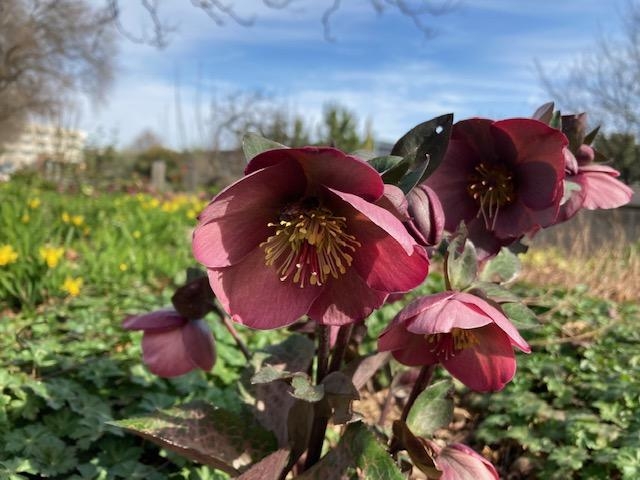A Rose?
When is a rose not a rose? When it is the Lenten Rose. Technically it is Helleborus x hybridus.
The cup-shaped, nodding flower is thought to resemble a rose. It earned the rest of its name from when it blooms – late winter until late spring, surrounding the season of Lent. It is a perennial hellebore in the Ranunculus family and grows from a rhizome. It can be found in USDA zones 5 – 9 and is native to Greece and Turkey. The blooms range in color from white to pink to rose to purple and the flowers emerge from under the old leaves of the plant. The flowers are actually sepals and that means the flowers last for weeks although the darker shades will become lighter. Eventually, the flower becomes a fruit and produces seeds and then seedlings if left undisturbed. The seeds can be collected and dried but require a bit of work (stratification) to get them to grow. While the flowers are one of the earlier eye-catching bloomers in the year, the leaves are equally attractive: large, leathery, glossy, dark evergreen in an umbrella configuration kind of like an outstretched hand. When the flowers are finished for the season, the leaves last in the shade for the entire year.
Plant your new Lenten Roses in moist but well-draining, rich soil in a partial to full shade, mulched location about 18 inches apart. Their preference is for alkaline soil. Don't expect flowers the first or even the second year after planting. The plants can be divided and moved, but it can take two to three years for them to recover. They can also be grown from seed but it takes up to 3 years for them to bear flowers. Once a Lenten Rose is established it is actually drought-tolerant. These are low-growing – 12 to 18 inches tall - and with their nodding blooms are best showcased in the front of a border. It does mean that to get a good look at them, you will need to get down on your knees or use a selfie-stick with your phone to take a picture. The leaves will form clumps 18 to 24 inches or larger. Keep that in mind when planting so that they don't need to be relocated. Plants can last 20 years!
To maintain your plants, you can clip off the dead leaves that surround the center of the plant at their bases just as they start to bloom, no earlier. The flower buds actually form during the summer before they bloom. The new leaves will highlight the blooms. Make sure to wear gloves when working on them- the plant releases skin-irritating alkaloids. Every bit of the plant is toxic to humans and pets if ingested. They are a great plant for dry shade and are naturally repellant to deer and rabbits. They are self-pollinating, but are also a source of pollen for the early bees and flies, when not much pollen is otherwise available. In fact, one second after I got down on my hands and knees and took this picture, a bee flew out from the center of the flower!


